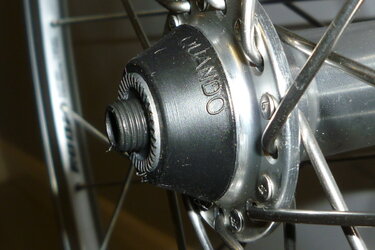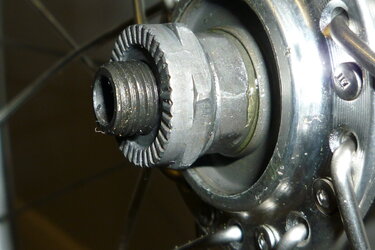Hope I'm not disappointed.
That was the kiss of death!
The wheel arrived yesterday, well-packed and undamaged and superficially it seemed fine. The wheel span true and spokes were of remarkably similar tension. I fitted new high-pressure rim tape (22-559) which was a snug fit (do you sense a 'but' coming...?)
To me, the bearings seem too tight and insufficiently free running so I wanted to adjust and set them for myself - as I have done with many wheels in the past - but I can't undo the axel nuts (please excuse my possible misuse of terminology). Besides, I also wish to ensure the bearings are properly greased. Now, I don't know if these are sealed bearings or not and if they are sealed, I appreciate there's little I can adjust but surely I should be able to undo the bearing/lock nuts?
I even gripped the locknut on one side in a fixed worktop vice and attempted to unscrew the other side. I could feel the axel twisting/flexing with my effort so I stopped. I've also tried undoing the locknut (second nut) on one side by gripping the bearing nut (first nut) on the same side without success. Tomorrow I could try Easol penetrating agent/release fluid or a hot air gun. Never needed to resort to these tactics before so interested to hear views.
Here are pics of the hub. Looks like a Quando. The bearing nut + locking nut look pretty conventional to me but am I missing something? Any suggestions or tips?
Also, in photo P1020516, I've re-fitted one of the soft rubber cone-type seals (?) that came with the wheel (one on each side). These soft rubber cones were greased and there are visible signs that the bearings have been greased too. Question: do these rubber cones stay in place when the wheel is used or should they be removed before use? They clearly add a little extra friction to what is already a slightly/moderately high friction wheel (i.e. compared to any other wheel I've ever owned - and that includes both sealed and loose bearing wheels).
Final thought: maybe the wheel is intended to be fitted 'as supplied' and I'm faffing about unnecessarily? Obviously, I could just return the wheel but then I'm back to square one and only too aware of the time I'm wasting on, what should be, a relatively simple matter.




 but I can tell you this for sure: leave the rubber bearings seal on the wheel, actually, protect those seals with your life
but I can tell you this for sure: leave the rubber bearings seal on the wheel, actually, protect those seals with your life  )
)